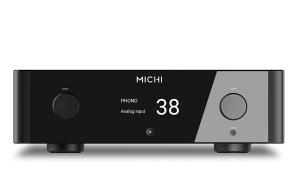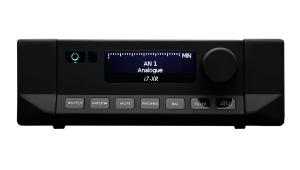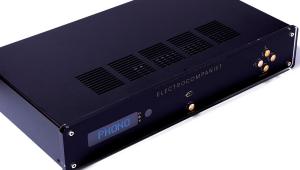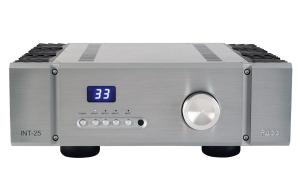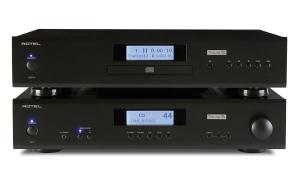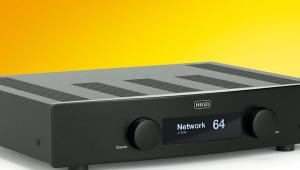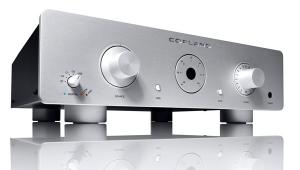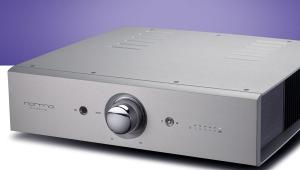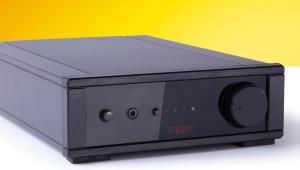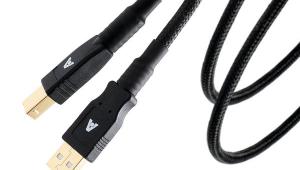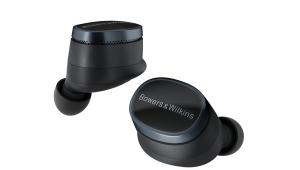Micromega AS400 - £3,898

Streaming digital music from your computer is a great idea, but it’s also a challenging one for the non-technical. Setting up such systems is getting a lot easier, but Apple’s Airplay is about as easy as streaming can be. All you need is an Apple touchscreen device or computer and an Airplay receiver, then you can play whatever is on the source wirelessly through the receiver. By combining the interface with the source cuts out a whole stage from regular wi-fi streaming systems. Micromega clearly likes the concept and is the first audiophile brand to make an Airplay-compatible integrated amplifier.
Library of titlesMicromega makes this distinction because Denon and Marantz both have Airplay-ready receivers and Bowers and Wilkins’ latest Zeppelin Air is also in on the action. Make no mistake Airplay could be very big indeed. Micromega’s system is dubbed ‘Airstream’ for licensing reasons, but it’s not exclusively designed for Apple sources; any computer using software called Airfoil (£15) from Rogue Amoeba can stream content to the AS-400. The company incorporated Airstream into its WM-10, which has been around for over a year and is also based on an Airport Express module, but it doesn’t have a Micromega DAC and power supply like this integrated unit, nor is it an amplifier.
What is crucial about this system is ease of set up. You don’t need a computer at all, nor a wireless network: all the transmission and reception is done by the amplifier and your player. As well as streaming from your music collection you can also send content from Deezer, Spotify and Pandora albeit only via using Airfoil software.
The AS-400 is a 400-watt (into four ohms) integrated with three line inputs, an MM phono input and the ability to operate as a preamp or power amp alone. It’s included because this is a Micromega IA-400 integrated amp with Airstream added, an extra that increases the price by over a thousand pounds!
Both amps have Hypex class D switching power amplifiers, one per channel, which are fed by a power supply with an extremely heavy toroidal transformer and four very large 10,000µF capacitors. It runs surprisingly warm for a switcher, but it’s a pretty powerful one with not a great deal of ventilation or obvious heat-sinking.
Control is via a selection of front-panel buttons and volume knob or a densely populated system remote, useful if you have other Micromega components we guess. Inputs can be named using a library of titles for the three line inputs but not for phono, Air or iPod. It’s perhaps surprising that something oriented to Airplay should have the latter, but only the iPod Touch can transmit wirelessly.
We would also have liked to have seen a USB input for a digital output from an iPod or computer, but this is not included probably because it’s all about streaming from such sources.
Set up is child’s play, once you notice the little icon on the bottom of the iTunes window which allows you to select which network the computer/idevice streams to. When you plug the AS-400 in its Airstream logo flashes red, while it boots up. You will then see MUSIC on your list of local networks and can join it with a default password. Then it’s a matter of clicking on the box with a triangle at its base in iTunes and selecting the Micromega. Simple.
Zero-toleranceIn terms of build, the fact that the AS-400 is a variant on the IA-400 means you get the construction and finish that Micromega can achieve in a £2,797 product, which is good but not outstanding for the money. It only has single-ended in and outputs, whereas many competitors offer balanced at this level and the remote is a fairly standard OEM type.
Front and rear panels are machined out of aluminium and being able to change input name is useful, more useful, however, would have been a USB input or digital inputs of some sort.
Primare’s (non-Airplay) i32 integrated (£2,200) has more inputs and includes two balanced pairs among them. It also has a rather more distinctive facia, with chunky stainless control knobs. It’s less powerful at 120 class D watts per channel, but seems like better value on the face of it.
There are a few high-power integrateds in the same fiscal ballpark as the AS-400 and the better examples include ATC’s 150-watt SIA2-150 (£2,599), Leema’s 150-watt Tucana II (£3,425) and Bryston’s 100-watt B100 SST (£4,899). These are all class A/B designs which are usually more expensive to build than class D types and all but the ATC have balanced connections, as well as more substantial casework than the £3,898 AS-400.
Build and spec is not everything, of course – power figures are notoriously misleading and none of these amps has the ability to stream either wirelessly or otherwise. But it’s more than likely that there will be plenty more appearing in the coming year.
Power playWhat first grabbed us about this amplifier is its power, the result lives up to the spec in many respects. It’s got a powerful, but smooth-edged grip that controls the bass in a muscular fashion; it makes up for the lack of balanced socketry and heavy machining the moment you put something with a bit of welly in the player. The immediacy and image- precision with a pair of ADN speakers is nothing short of gripping; this is a speaker that likes power. At this point we stuck a Primare i32 into the system to see if the price difference makes sonic sense. It does: the Micromega is considerably better at revealing space, the acoustic of the recording, not to mention its dynamics and timing. There really isn’t any contest; you clearly get more for your money.
On the all-important Airstream front we used a Macbook to make a direct comparison between the laptop’s optical output via a Stello DA100 Signature DAC and an Airstream feed. The latter produces a considerably wider soundstage in the context of a more relaxed presentation when using iTunes alone as the player, however if you add the Pure Music player into the mix this gives the optical output a significant edge by adding improved dynamics to the mix. The Stello is a £750 convertor and Pure Music costs £80, so the combined cost approaches that of adding Airstream to the IA-400 when you take a decent optical lead into the equation.
As we also had Leema Acoustic’s Tucana II to hand, this was brought into the fray to see how the AS-400 compared with something in the same price arena. It proved to be tonally richer and able to deliver greater depth and dynamics compared to the Leema, which produces a more solid, but less refined sound, which is a pretty good result.
Apple at its coreWhat is most appealing about this amp is being able to sit down with an iPad and play whatever you like, it’s a world-class interface and the sound produced is clearly superior to that available with an analogue connection.
At heart this is a rather good amplifier: its musical, dynamic and has bags of power. Input selection is a bit limited and the build quality could be better, but if it’s sound you are after then this hits the mark. And thanks to the Airplay factor, it’s a doddle to set up and start enjoying.
LIKE: Airplay compatibility; smooth and revealing sound quality
DISLIKE: Build quality is not up to par for the price; needs more line inputs
WE SAY: Airplay could be the future of streaming and the AS-400 proves that it’s got real audio potential
DETAILS
PRODUCT: Micromega AS-400
Origin: France
Type: Streaming integrated amplifier
DIMENSIONS: (WxHxD) 430x95x375mm
Weight: 13kg
FEATURES:
• Airstream sample rate 16/44.1
• Formats: AAC, AIFF, ALAC, MP3, WMA, WAV
• Power output: 400w/4 ohms
• MM phono input
• Inputs: 3x line, processor, sub, iPod
• Outputs: sub out, pre-out, headphone
DISTRIBUTOR: Absolute Sounds
TELEPHONE: 020 8971 3909
WEBSITE: micromega-hifi.com
 |
Inside this month's issue:
Q Acoustics 3020c standmount loudspeakers, Perlisten R10s active subwoofer, Quad 33 and 303 pre/power amps, Acoustic Solid Vintage Full Exclusive turntable, newcomer Fell Audio Fell Amp and Fell Disc and lots, lots more...
|




